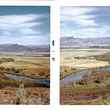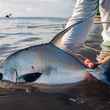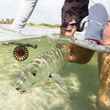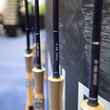UPDATE: For our most recent picks for the best fishing sunglasses, check out feature Best fishing sunglasses for 2018-2019.
Over the years, we’ve produced few “best of” features, for a variety of reasons. Mostly, this is because we find such features to be largely disingenuous. No one that claims to have selected the “best” this or that has fully tested all of the options out there and even if you could presume they had, chances are they’d be unqualified or otherwise lack the expertise to draw such lofty conclusions.
Count us amongst the unanointed and incomprehensive. We’ve certainly not tested every pair on the market and we possess no credentials whatsoever in the world of optics, ophthalmology and so on. So why do a “best of” feature for sunglasses?
Because sunglasses are one of the most important pieces of fishing gear and in many fishing scenarios they become unquestionably the most important tool in an angler’s arsenal. Over the years, we've amassed extensive experience navigating lens technology and how it translates on the water. Fishermen face a dizzying array of options from a fairly wide field of manufacturers and knowing not only which sunglasses perform at a high level, but which are best suited to your type of fishing can be difficult. The hope is that bringing our experiences to bear on these decision making efforts will prove considerably valuable.
But, as we’ve noted in previous years. Take “best of” with a sizable grain of salt. After countless hours of testing — swapping lenses and frames and so on through a wide array of fishing locales and conditions across several different continents — these are, put simply, the sunglasses we reach for when we’re on the water chasing after fish.
Best Low Light: Maui Jim HT
The more things change, the more they stay the same. The reality is, not much has changed in the world of sunglasses since our last rodeo. Mostly, we’ve seen a few incremental additions from manufacturers and have gotten to spend more time with technologies that debuted around the time we did this a couple of years ago.
Amongst the unchanged is our goto pair of glasses for low light conditions. Maui Jim’s HT lens was our favorite low light performer in our first feature back in 2011 and it remains so today. Back then we touted its clarity and versatility — including its ability to take you through varying conditions on all but the sunniest of days — and we continue to do so.

We’ve also grown to find noteworthy its neutral tone, a quality we’re not drawn to in any other class of lens. When utilizing a low light lens not only as secondary eyewear when the sun is tipped towards either horizon, but as a versatile lens for days with changing light conditions (read: days with fast moving clouds and approaching storms, days spent on small creeks with vegetation lined banks and often sun-choking tree canopies, and so on) the neutral tone of the Maui HT seems to play less havoc on the eye as conditions shift.
BUY THE MAUI JIM HT (via Amazon.com)
Also look at: Smith Techlite Low Light Polarized Ignitor
If you’re looking for solely a low light performer, skip Maui’s HT and look at Smith’s Techlite Low Light Polarized Ignitor lens. Though less versatile, Smith’s Ignitor and its 40% VLT (visual light transmission) will take you places Maui Jim’s HT (at 29%) won’t. And those places are dark. Or at least they seemed that way until you donned Smith’s Low Light Ignitor lenses.
These glasses are a favorite on those truly overcast days or on evenings where the hatches don’t seem to come until it’s almost impossible to see to tie on a new fly. They’ve also served us very well in the salt, chasing snook in the mangrove or trying to spot permit cruising the edges of lagoons, on those dead flat days when the whole world seems to lack contrast.
BUY THE SMITH TECHLITE LOW LIGHT IGNITOR (via Amazon.com)
Best Saltwater: Costa 580G Green Mirror
We hemmed and hawed a couple years back when trying to make our decision for best saltwater lens. To Costa’s credit, the choice was between two of their lenses: their 580G Blue Mirror and their 580G Green Mirror. Costa touts the blue version as intended for blue water excursions where anglers chase quarry such as tuna, dolphin, sailfish and so on in offshore locations, while the green is aimed at nearshore anglers in search of bonefish, permit and the like in relatively shallow waters.

Two years ago, we went against the grain and opted for the 580G Blue Mirror, finding it more well suited to both types of saltwater fishing than we did the 580G Green Mirror. But we’ve changed our minds. Rather, we’ve spent another two years fishing various frames with both these lenses aboard and have found the greener of the two to be better at piercing through the sun glaring off the ocean’s waters and giving us a sometimes breathtakingly clear, contrast-filled view of the world below.
To be clear: both lenses are excellent performers and you’ll be well served by either pair. If you spend more time offshore, opt for the Blue Mirror and wear it with confidence near shore — and vice versa.
We’re also pulling back on our recommendation of Costa’s 400G lens. Not in general, they are quality specs, just not as an almost-replacement for the 580G. Just as more time on the water has taught us that Costa’s own recommendation for where to fish which lens was accurate, it has also taught us that the added clarity of the blue and yellow-blocking technology (ranges around roughly 400nm and 580nm respectively) in Costa’s 580 lenses can’t be mimicked by lenses that lack it — and this added clarity may be more evident in the salt than it is anywhere else.
BUY THE COSTA 580G GREEN MIRROR (via Amazon.com)
Also look at: Costa 580G Blue Mirror
This is essentially just a restatement of what we said just above, for those of you that are skimming rather than reading. Both the green and blue mirror lenses from Costa are excellent saltwater performers. If you spend more time in blue water (offshore, chasing fish in more than 10 feet of water), then go for the blue mirror instead of the green.
BUY THE COSTA 580G BLUE MIRROR (via Amazon.com)
Also look at: Smith ChromaPop Blue Mirror
Smith has created a lot of fans with its relatively new lineup of ChromaPop lenses, and with good reason. Smith's ChromaPop technology is, like Costa's 580G, based on color-blocking — although it employs a different scheme. The results can be dramatic. Smith's ChromaPop Blue Mirror, which is backed by a grey tinted lens with a blue mirror front coating, lenses are excellent performers on both the flats and in blue water and wear very light thanks to their plastic construction (more on this later). Forced to chose between the two, we'll grab for Costa's 580G, but we'd never feel under-gunned wearing the Blue Mirror ChromaPops and there were times when the Smith's offered that "special something" that the Costa's lacked.
BUY THE SMTH CHROMAPOP BLUE MIRROR (via Amazon.com)
Best Full Sun: Costa 580G Copper / Smith ChromaPop Bronze Mirror
Since saltwater gets its own category, "Best Full Sun" applies mostly to freshwater fishing. And. if we're fishing the sun-baked Missouri or Madison in July, we're most likely to hit the water with either Costa's 580G Copper lens or Smith's ChromaPop Bronze Mirror lens. Both lenses feature color-blocking technology, in an effort to increase clarity and contrast.
Smith’s color-blocking technology, ChromaPop, does so in areas of what Smith calls “color confusion”. Specifically, this is in two areas: one where red and green wavelengths intersect (ranges roughly around 450nm and 580nm, respectively). While Costa's color blocking 580 lenses do so in a different wavelength range on the blue end of the spectrum, and the results produced by the two lenses do differ, both definitely produce a visual field with more “pop” (hence the namesake on Smith's part) and one where well-camouflaged subjects like placidly finning rainbows and bottom-dwelling brown trout can be considerably easier to spot.

Smith’s ChromaPop lenses are plastic and as such won’t offer the same optical clarity of glass. That said, it is important to note that the plastic in question here is Trivex — a well-heeled material in the world of sunglasses (used also by Costa in its 580P lenses and by other brands such as Kaenon) that is said to provide near-glass optical quality. For the most part that’s true, and that’s why these lenses have proven to be a goto lens when there’s sufficient light along for the ride. On those days, the “it” affect of Smith’s ChromaPop technology and the benefits of its light-wearing Trivex-constructed lens won out over the added clarity provided by glass.
That’s a sword that cuts both ways, however, and we did find that in more challenging conditions we were more likely to reach for a glass lens (often one of Smith’s own).
BUY THE SMITH CHROMAPOP BRONZE MIRROR (via Amazon.com)

If you're a stickler for the optical quality that only comes with glass — even if the heavy sun you'll be fishing in won't likely make you miss it — and don't mind the extra weight of glass, then Costa's 580G Copper lens may be your best grab. As noted, color-blocking technology is on board here as well, and the effects are notable. Also onboard is Costa's hallmark for clear, crisp lenses.
BUY THE COSTA 580G COPPER (via Amazon.com)
Also look at: Smith ChromaPop Brown
Another ChromaPop option that differs slightly in character (read: tint) from its bronze-mirrored brethren. The main difference here, however, is in VLT. With a 14% VLT, the ChromaPop Brown Mirror is a somewhat brighter option worth considering if you’re looking for a little added versatility.
BUY THE SMITH CHROMAPOP BROWN (via Amazon.com)
Best Overall: Smith Techlite Glass Polarchromic Copper Mirror
We’re going to hedge our bets here a bit even though we’re sticking with our guns by naming Smith’s Techlite Polarchromic Copper Mirror lens as the best all around fishing lens out there. And, we’re standing by everything we said last time, namely:
“In our minds, being best overall means offering more than everyone else does. But how do you quantify sunglasses? Well, as far as we're concerned, you quantify them by assessing their versatility. If you fish in a considerably diverse array of environments -- as many of us do -- and can own only one pair of fishing sunglasses, then a pair Smith Optics Polarchromic Copper Mirror Lens should probably be it. Thanks to the polarchromic aspect of this lens -- which means it self-adjusts its darkness dependent on the sun conditions -- these lenses do the job in virtually any scenario. In fact, we found it hard to find a scenario in which these lenses wouldn't do.”

Finding what’s “best” is often most about finding the tool that’s most suited to the job, and that’s the main thing that makes the Smith Techlite Polarchromic Copper Mirror shine: it’s the right tool for so many jobs, thanks in no small part to its stunningly clear optics and versatile, polarchromic 12-20% VLT profile that adjusts throughout the day as ambient light conditions change.
That said, over the last year or two, Smith’s Techlite Copper MIrror has faced a some stiff competition from another of Smith’s Techlite polarchromic lenses.
BUY THE SMITH TECHLITE POLARCHROMIC COPPER MIRROR (via Amazon.com)
Also look at: Smith Techlite Polarchromic Amber
Like its copper-mirrored kin, the Smith Techlite Polarchromic Amber lens is a startlingly clear, contrasty lens that adjusts its VLT through the day. The tough choice has been which to reach for. The amber lens’ brighter 15-30% VLT profile makes it much more well suited to overcast days and may also make it the choice for older eyes that aren’t what they used to be, which benefit from more available light. Still, at most times the Techlite Polarchromic Amber feels more like a low-light lens than it does an all-around performer, which keeps it second in line to its sister lens.
BUY THE SMITH TECHLITE POLARCHROMIC AMBER (via Amazon.com)
Also look at: Smith ChromaPop Polarchromic Ignitor
Bearing more in kind with Smith’s Ignitor lenses from its ski lineup than the Low Light Ignitor mentioned earlier here, Smith’s ChromaPop Polarchromic Ignitor brings the best of the ChromaPop color-blocking technology and the Techlite polarchromic technology into one lens. So what’s to keep it from being best overall? Its tint. The Smith ChromaPop Polarchromic Ignitor features a rose-colored tint that some testers swore by, while others simply liked less than copper, brown and amber tints in comparable lenes.
BUY THE SMITH CHROMAPOP POLARCHROMIC IGNITOR (via Amazon.com)






























Comments
Steve K replied on Permalink
At your recommendation, I bought the Smith chromapop when they came out last year in an Rx version.
Best sunglasses I've ever owned, by far.
Chad Shmukler replied on Permalink
Glad to hear it, Steve. Which ChromaPop lens did you end up with?
Matthew21 replied on Permalink
Did anyone have trouble finding a dealer they can use their insurance with? I was hoping to save a little out of pocket on these if possible? Any suggestions?
Linda Friedman replied on Permalink
Always bring your fishing hat with you when buying a pair of glasses. I didn't and now pay the price for that mistake.
MikeK replied on Permalink
No options under $150 here...I understand that, but it would also be nice to have a "best budget option" category for sunglasses under $100.
Chad Shmukler replied on Permalink
Will keep that idea in mind, Mike. For what it's worth, many of these pairs can be had under $150 (even if that's not their MSRP). We try to keep the provided Amazon links updated to follow the best deals on Amazon (which sometime come in as low as $125 for some of the models), but doing so is a bit like herding cats.
Tapis replied on Permalink
Amazon is evil. Is there anywhere else to buy from online.
Chad Shmukler replied on Permalink
I'm sure Google will reveal any number of additional retailers.
Greg franklin replied on Permalink
I'm really surprised Kaenon isn't anywhere on this list they are in my opinion the best glasses I have owned. Where they not included or just didn't make the cut??
Keith Oderman replied on Permalink
I have come to believe that the higher VLT, the better fishing sunglasses, right up to the point where you squint so hard that you get headaches. Less light to your eye means seeing less detail, simple as that. You wouldn't want your brain surgeon operating on you wearing dark glasses, would you?
Andrej Saule replied on Permalink
What are the glasses that the guy in the middle of the photo is wearing. Ive seen them once before but can't remember the name of the model?
simon replied on Permalink
Hi, what is the difference between the smith optics polarchromic copper mirror lens and polarchromic copper? As you don't mention it in any of your reviews! I've just ordered a pair of smith optics 'dolen' with the polarchromic copper lens for general everyday use and freshwater fishing in the uk, as I prefer the cosmetic looks of that lens. But am now slightly worried that it is not going to give me the best all round use that you recommend the copper mirror lens will do!
Chad Shmukler replied on Permalink
There's a real subtle difference here, Simon. Smith itself doesn't clearly separate these two lenses. The copper mirror lenses have what Smith calls a "subtle silver-flash mirror coating" which helps repel glare. But, it also states a anti-refective coating on the non-mirror copper lens as well. To further confuse things, Smith lists the same VLT (13-20%) for both lenses.
In our experience, you get a bit more glare resistance from the Copper Mirror vs. a bit more VLT (despite the identical 13-20% rating) from the non-mirror copper lens.
Most importantly, I wouldn't spend much time worrying that you bought the wrong lens. Both the copper mirror and copper lenses are excellent, and you'll by well served be either.
In fact, the exact pair you mention — the Smith Dolen w/ Copper Polarchromic lens — has been my everyday fishing lens for the last year or so, with few exceptions.
simon replied on Permalink
Thank you so much for the prompt reply Chad. I've been using fairly cheap plastic type lensed polarised glasses for the past 10 years, as I wear them to work aswell. I've always wanted a quality pair of polarchromatic sunglasses with polarization and read on a few websites that these don't exist. I was sure they did and when I came across your reviews, I had to get a pair. As usual though the UK shops didn't sell them and import duty is pretty much 20% of the total price including shipping. Alot of searching and I found a seller with good feedback and guarantees for selling them at the same price as costas are over here. I just had to buy a pair. Thanks again for your excellent reviews!
Matt replied on Permalink
So after 2 days of researching I can't decide between the chromopop polarized bronze mirror lense and the polarchromic copper. Was looking at the Smith Guides Choice in both options. Plastic vs glass, the glass is not available in the mirrored option currently. After much digging around I found an overstock pair of Smith Chief Polarized Sunglasses - Polarchromic Copper Mirror, which is the best of both worlds and bought em for $130 (off of $220) from REI. The frames aren't as thick on the stems as the guides choice but hopefully they will be great, I doubt they are techlite as they were made in 2013 apparently but oh well. If I don't like them I can return them and then its back to the chromopop bronze mirror vs techlite polarchromic debate...Thanks for the great info!
NicO replied on Permalink
Hello,
Please, I need an advice.
It’s for fly fishing when it’s not too much sunny or when the river cross a woods and there’s shadows on the river, or for the end of a day for example...
You say that the Smith Techlite Low Light Polarized Ignitor is the best option but it seems impossible to buy in France.
So, for you, which is the best other option :
- The Smith Dockside Chromapop Polarchromic Ignito
- The MAUI HT
- Other
Thanks in advance !
NicO
Chad Shmukler replied on Permalink
Nico,
Apologies for the delayed reply.
Give the conditions you're describing, primarily wooded streams where you're moving in and out of light and dark areas, I'd go with the Maui HT.
They'll provide better visibility in low light vs. the ChromaPop Ignitor (which maxes out at 20% VLT - the Maui HT is 29% VLT).
It also is important to note that all the polarchromic or photochromic lenses, while versatile, need time to adjust their VLT. When you go from dark conditions to light conditions, it takes time for them to adjust. While it might only take a minute or two, if you're moving along a wooded stream where you quickly go from darkly shaded areas to sun blasted areas, they won't adjust quickly enough.
The HT, for it's part, is good in variable sunny conditions. Out on a sun bleached western river or on blue water? It wouldn't be my first choice ... but in variably sunny conditions, such as the wooded situations you describe, it is a great performer.
DanD replied on Permalink
Hello. Great review. I always enjoy reading your sunglasses review each year. I do have a question though. It appears that many of your "best picks" are some type of copper based lens. For example, the green Costas above are just the same copper lens with a green coating. Would these be just as good as the Copper lens in the full sun for river fishing? Could the Copper Costas be as good as the Copper silver mirror Smiths? While the Smiths are photo chromatic, this feature offen does not worked as advertised unless the user is in full sun light. It can be of limited use if the fisherman is wearing a hat.
Chad Shmukler replied on Permalink
Dan -
The bit about the hat is a misnomer. Whatever light is reaching your eyes is reaching the front of your sunglasses -- in fact the light reaching your eye is passing through the sunglasses. All of that light is light reflected off objects in your field of view -- unless you're staring into the sun, which we all know is a terribly bad idea.
The Smith Techlite Polarchromic copper and Costa 580G lenses are different animals. Smith's lens has the variable VLT, which gives it versatility. The Costa lenses have Costa's color blocking technology. Green mirror vs. Copper? Yes, Green Mirror has a Copper base so they are similar. The Green mirror cuts the VLT from 12% to 10%, so they fare a bit better in brighter conditions. The mirror also seems to help cut glare a bit, which is welcome in the salt and other environments where you get a lot of glare.
All 3 are excellent, glass lenses with stellar clarity. You'll be well served by any of them. Which is right for you likely comes down to what sort of conditions/locales you normally fish in plus personal preferences.
Jaime replied on Permalink
Hi,
I am hoping you can help me. I have read this whole thing and I am still not sure which sunglasses would be best to buy my husband for Father's Day. We live in Florida in the Clearwater area. My husband does most of his fishing from his kayak in saltwater, however several weeks out of the year in NC and this Aug. in VT he will fish in streams. I believe mostly for trout. (brown, rainbow) Are there a pair of sunglasses that would be perfect for both the Florida kayak fishing and the northeastern streams fishing?
dannnny replied on Permalink
What kinda of sunglasses are shown in the main article photo?
Dave replied on Permalink
I'm looking at replacing my 15+ year old Action Optics glass lenses. The frames finally gave out. Anyway I live in Colorado and these glasses would be dedicated for fishing. That said I'll only have one pair so I'm looking for the best all around lens for my conditions. Cloudless days, overcast days and in between. Late evenings, dusk, etc. when sun is low on horizon performance is a huge plus.
Thanks
francis martin replied on Permalink
Hi, I was interested to read that the SMITH TECHLITE GLASS POLARCHROMIC COPPER MIRROR are the lenses to pick as a good general lens. I can't seem to find them in prescription so I guess they aren't available. Pity as a good all round lens would be useful particularly with the cost of prescription sunglasses.
Interesting to see that a number of manufacturers use Trivex; it would be interesting to know how these compare (re contrast etc).
Thanks for the article; the above are just a couple of personal views.
Jeff replied on Permalink
For nearshore saltwater the 580G lens is the best I have seen. Sadly, in my experience Costa frames that hold them tend to snap by donning them during routine wear
Charles Wynn II replied on Permalink
Have you had the opportunity to try out any RCI Optics products? I know they're a relatively new upstart in the industry but their products look like the real deal. I would love to hear your opinion on the H780 copper lenses.
I live in Tampa and fish primarily inshore saltwater and freshwater lakes ponds. I was also looking at the Maui HCL bronze which used to be on your list. I really like the fit and feel of their frames.
Thank you!
Charlie
Pages